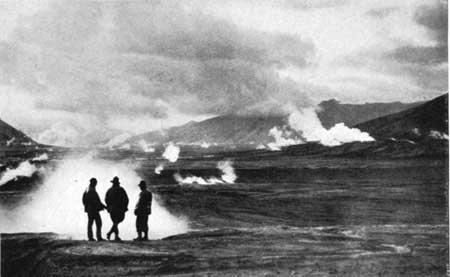![]()
MENU
|
Glimpses of Our National Monuments KATMAI NATIONAL MONUMENT |

"Valley of Ten Thousand Smokes".
Photo by D. B. Church. Courtesy National Geographic Society.
Katmai National Monument, situated near the base of the Alaska Peninsula on the southern shore of Alaska, bordering Shelikof Strait, lies midway of a volcanic belt which has shown extraordinary activity during recent years, and is the largest and most spectacular member of the monument system, with an area of over a million acres. Here is located Mount Katmai, which in 1912 gave vent to a violent eruption, the initial stage lasting three days, during which several cubic miles of material were emitted. This eruption was of such violence as to rank in the first order of volcanic explosions. The crater left by the explosion, measured along the highest point of the rim, has a circumference of 8.4 miles. The volcano is now quiet, and in its crater lies a lake of milky blue water over a mile long and nearly a mile wide, in which is a little crescent-shaped island measuring 400 feet from tip to tip.
The most spectacular feature of the monument is the mountain-encircled "Valley of Ten Thousand Smokes" in the northwestern portion of the reservation. For over 15 miles down this valley, which measures 9 miles at its greatest width, the ground is broken open, giving vent to several million fumaroles or little volcanoes, from which rise jets of steam. Some of the jets throw their steam over a thousand feet into the air, and hundreds of others go up to a distance of 500 feet, all merging above the valley into one titanic cloud. These fumaroles are surrounded by deposits tinted in all the shades of the rainbow, and present an incomparably beautiful and awe-inspiring spectacle. The "Valley of Ten Thousand Smokes" was first discovered in 1916 and was explored in 1917 by the National Geographic Society's fourth expedition to this region. The explorers had many thrilling adventures. They cooked their meals over the nearest hot vent wherever they happened to be, and their tent, heated by the steam, was much too warm for comfort. In many places they found the ground far too hot to walk upon. Scientists say that this astounding valley is an example of what the geyser basins of Yellowstone Park were at the time when Yellowstone's volcanoes first ceased their activity, and they predict that in the course of time, probably taking many centuries, the surface here will cool sufficiently for the vents to retain water some distance down. When this happens the steam below, pressing against the water near the surface, will force this water upward into the air, and a new geyser field will come into existence.
In addition to the volcanic phenomena, the surrounding region contains some magnificent lake and mountain scenery. Waterfowl and fish are abundant, as are the great Alaskan brown bears, the largest of carniverous animals.
The land was set aside as a national monument by presidential proclamation dated September 24, 1918, and on September 5, 1923, the area was reduced by the elimination of 10 acres, leaving a total of 1,087,990 acres.
At present the Katmai National Monument is comparatively inaccessible, but the last expedition party of the Geographic Society in 1919 discovered Geographic Harbor at the head of Amalik Bay, previously uncharted, which may in the future afford a fine entrance to the region. When this harbor can be developed and an automobile road about 30 miles in length constructed into the area it will be readily accessible and will undoubtedly draw many visitors. Until this development takes place none but the most experienced and hardiest of mountain climbers and explorers should attempt a visit to the region.
|
|
Last Modified: Thurs, Oct 19 2000 10:00:00 pm PDT
glimpses2/glimpses16.htm

 Top
Top